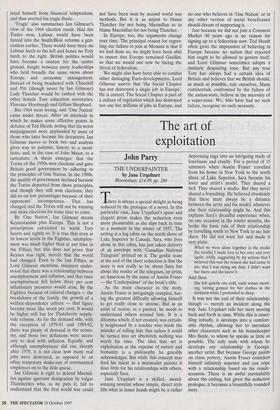The art of exploitation
John Parry
THE UNDERPAINTER by Jane Urquhart , Bloomsbury, £14.99, pp. 280 here is always a special delight in being seduced by the prologue of a novel. In this particular case, Jane Urquhart's spare and elegant prose makes the seduction even more pleasurable as she slips back in time to a moment in the winter of 1937. The setting is a log cabin on the north shore of Lake Superior in Canada. Sara, who lives alone in this cabin, has just taken delivery of an envelope with 'Canadian National Telegram' printed on it. The gentle tease at the end of the short seduction is that the story is not really to be about Sara but about the sender of the telegram, an artist, an American by the name of Austin Fraser — the `Underpainter' of the book's title.
As the main character in the story, Austin Fraser is intriguingly complex, hav- ing the greatest difficulty allowing himself to get really close to anyone. But as an artist of course, as a painter, he needs to understand others around him. It is a dilemma which, if not created, was certain- ly heightened by a teacher who made the mistake of telling him that unless it could be turned into art absolutely nothing was worth his time. The idea that art is exploitation at the expense of nature and humanity is a philosophy he greedily acknowledges. But while this concept may feed his talent as a minimalist painter it does little for his relationships with others, especially Sara.
Jane Urquhart is a skilled, award- winning novelist whose simple, direct style lifts what in lesser hands might be a rather depressing saga into an intriguing study of loneliness and cruelty. For a period of 15 summers when Austin Fraser travelled from his home in New York to the north shore of Lake Superior, Sara became his lover and artist's model. They shared a bed. They shared a studio. But they never shared a friendship. He believed absolutely that there must always be a distance between the artist and his model, whatever else their relationship might be. And this explains Sara's dreadful experience when, on one occasion in the winter months, she broke the basic rule of their relationship by travelling south to New York to see him there. He did not want her and made it very plain: When we were alone together in the studio [he recalls] I made love to her over and over again, coldly, suggesting by my actions that I believed this was the reason she had come to me, that I was doing my duty. I didn't want her there and she knew it.
And then:
She left quietly one cold, early winter morn- ing, having groped for her clothes in the darkness while I pretended to sleep.
It was not the end of their relationship, though — merely an incident along the way. Jane Urquhart tells her story moving back and forth in time. While this is unset- tling initially, it develops into a comfort- able rhythm, allowing her to introduce other characters such as his housekeeper Mrs Boyle, to whom he speaks as little as possible. The only male with whom he develops any relationship is George, another artist. But because George paints on china pottery, Austin Fraser considers himself infinitely superior and can cope with a relationship based on his conde- scension. There is an awful inevitability about the ending, but given the seductive prologue, it becomes a beautifully rounded story.


























































































 Previous page
Previous page